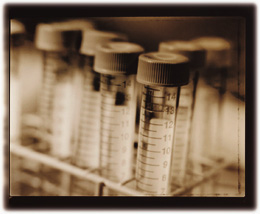Main Menu · Search · Current Issue · Contact · Archives · Centennial · Letters to the Editor · FAQs
  |
In 1978, Louise Brown, the first "test tube baby," was born in England. For the first time, a woman with blocked fallopian tubes who could not be helped by conventional surgery could hope to conceive and bear her own child through in vitro fertilization.In IVF, a woman's ovaries are drug-stimulated to produce 10 to 20 eggs, rather than the normal one or two. When mature, these ova are surgically "harvested," or retrieved. Each egg is then combined with 75,000 to 100,000 sperm in a glass petri dish--hence in vitro ("in glass") as opposed to in vivo ("in body"). The next day, two nuclei mean that fertilization has occurred. Forty-eight to 72 hours after retrieval, the embryos are ready for transfer back to a woman's uterus. Then a couple waits to see if implantation "takes" and a pregnancy has begun.
Since 1981, more than 33,000 babies born in the United States have been conceived via assisted reproductive technology (ART). Sperm banks, egg donation, embryo freezing, and surrogacy have been added to the popular lexicon, along with an alphabetic array of high-tech variations on IVF, including GIFT, ZIFT, and ICSI (pronounced ICK-see). GIFT (gamete intrafallopian transfer) involves the same course of fertility drugs and egg retrieval as IVF, but the eggs and sperm are returned to a woman's fallopian tube, the natural site for fertilization. ZIFT (zygote intrafallopian transfer) is like IVF, except that the zygote (the fertilized egg) is returned to the fallopian tube, not to the uterus. Some specialists claim that GIFT and ZIFT may increase the likelihood of implantation--the biggest sticking point in ART--by allowing the fertilized egg to follow its natural course to the uterus. Both require that a woman's fallopian tubes be intact.
ICSI (intracytoplasmic sperm injection), discovered by accident in Belgium in 1991, is the most recent addition to the ART family. To cause fertilization, an egg is perforated and a single sperm is injected; any resulting embryo is then transferred to the uterus or the fallopian tubes. ICSI represents "a huge advance for treating male infertility," according to Mark Hornstein '77, director of the in vitro fertilization program at Brigham and Women's Hospital.
The success rates for IVF and other ARTs vary widely from clinic to clinic, depending on screening policies (especially regarding age and type of infertility), available medical protocols, and expertise. The average success rate for standard IVF procedures in 1994, the most recent year for nationwide data, was 21.7 percent deliveries per cycle initiated. At Brigham and Women's, the 1994 delivery rate per IVF cycle for women under 40 was 26.44 percent; for women over 40, it was 5.36 percent. At Boston IVF, for standard IVF in the same year, the delivery rate for women under 40 was 16.5 percent; for women over 40, it was 6.41 percent. (The Boston rates apply to cases where there was no male factor infertility involved.) The nationwide success rates for GIFT and ZIFT are higher, at 28.5 percent and 29.1 percent respectively. The highest overall birth rate--46.8 percent--is found with donor eggs, in which the eggs of a fertile, usually younger woman are fertilized in vitro and transferred to the uterus of an infertile woman.
Since the chances of a fertile couple conceiving in any given month are only about 20 percent, ART raises an infertile couple's odds (per attempt) to fertile odds. But conceiving in vivo and in vitro are two quite different things. "Sex usually feels good, and it's easy, and it's free--not so with assisted reproductive techniques," says Susan Pauker, assistant clinical professor of pediatrics and chief of the genetics department at Harvard Pilgrim Health Plan. The median cost of one cycle of reproductive assistance is $7,800, according to the American Society for Reproductive Medicine. If a couple doesn't succeed at first, they often try three or four times before having a baby or giving up. With little or no insurance coverage available, 85 percent of those fees comes out of patients' pockets.
It is estimated that half the people who suffer infertility never seek a doctor's opinion, and of those who do, approximately 50 percent don't complete the infertility evaluation or the treatment plan. "People think of millions and millions of people getting treatment, when in fact, most people don't go for treatment, and a very, very small percent go for ART," says Alice Domar, director of the Mind/Body Center for Women's Health at Beth Israel Deaconess Medical Center. Many of them hold out hope for a spontaneous cure. Among couples who pursue treatment, some studies show that one third conceive on their own within two to seven years of discontinuing infertility therapy. But Mitchell Rein, assistant professor of ob-gyn and reproductive biology, says, "There's no question that ART is the single most successful treatment for the majority of cases."
Main Menu ·
Search · Current Issue · Contact · Archives · Centennial · Letters to the Editor · FAQs
![]()